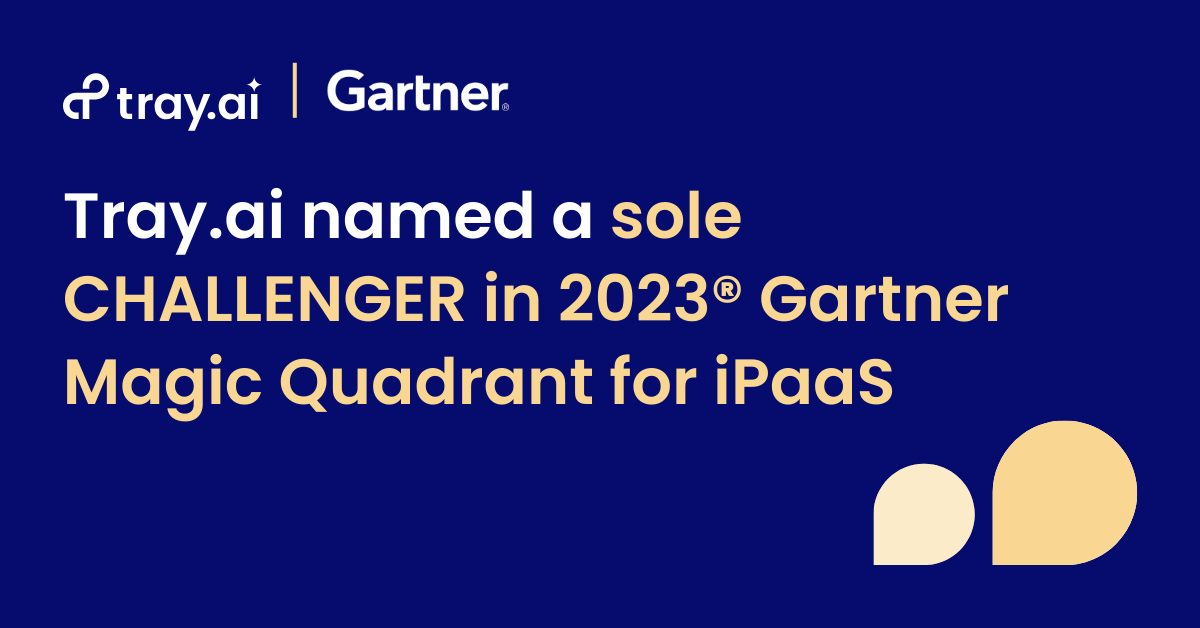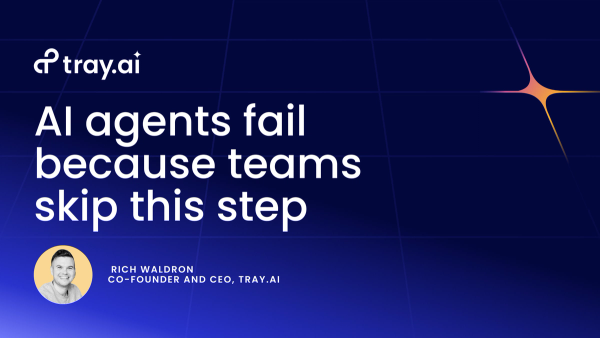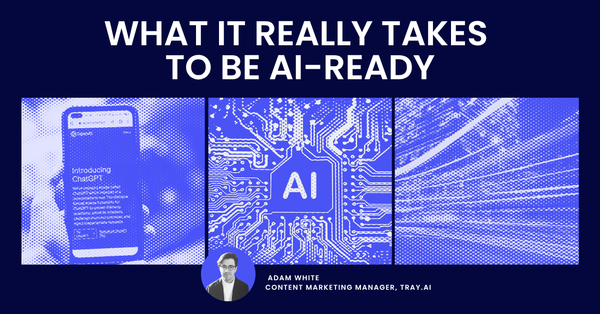Tray.ai is proud to be named a sole Challenger and one of just 16 vendors out of more than 150 that Gartner tracks to be included in the just-published 2023 Gartner Magic Quadrant for Integration Platform-as-a-Service (iPaaS) report. As the sole Challenger, and with momentum in both Completeness of Vision and Ability to Execute, we’re excited to be transforming a software category that is now instrumental to organizations of every size. Tray.ai is at the forefront of three major shifts underway in this market that we will explore in detail:
- User experience is now crucial to integration and automation success.
- Teams want to get hands-on and build from the get-go.
- Continuous innovation is now paramount to keep pace with change
Integration and automation are now at the center of business. According to Gartner, “Given the advanced capabilities and immense scale of iPaaS vendors, this technology has become the strategic integration platform of choice for hundreds of thousands of organizations around the world. In many cases, iPaaS has replaced previous generations of integration platform software such as application integration suites, data integration tools and B2B gateway software."
In fact, iPaaS is one of the fastest-growing software segments(1) as companies must now connect tech stacks that are more complex than ever. Often numbering in the hundreds, cloud apps across marketing, sales, finance, and HR, are usually held together by incredibly manual processes and brittle integrations. But more importantly, companies must innovate, differentiate, and lead with world-class business processes to gain competitive advantage - the apps themselves are no longer enough. And that requires a whole new class of modern iPaaS built precisely for that.
iPaaS is the enabler for a broader shift: the move to hyperautomation—where everyone has the power to automate business processes in every department. And companies can achieve it at scale.
It means iPaaS is undergoing the most significant disruption in years because the old way is unsustainable. The move is from staid decades-old integration software owned and operated by IT-only and hard-core specialists and developers to a place where business teams closest to the business process can go to rapidly and collaboratively build, integrate, automate, and continually improve.
Modern iPaaS is the key for organizations to achieve the velocity and agility they need to come to terms with a changing business environment while simultaneously overcoming the developer talent gap and cutting costs and maintenance around complex code-centric integrations that drain IT budgets.
At Tray, we built our platform so that companies can build quickly and collaboratively at scale. It is a modern and flexible low-code experience that visualizes integrations and automations exactly how you’d draw and use them, without compromise ― so they’re easy to comprehend and maintain. We put collaboration at the core to enable teams to work efficiently together in real-time, all with governance, security, reusability, and controls. And we designed the whole platform to be highly parallel and serverless so teams can scale up without headaches. With Tray Embedded, we also equip product and service teams to accelerate integration velocity and deliver value to their customers. These teams can effortlessly build and deliver product integrations at scale.
It's a whole new way for organizations to build that unlocks opportunities for companies of every size. This is one of the crucial reasons why Tray was the only Magic Quadrant integration platform provider to secure an expanded round of funding in 2022 to further fuel innovation and growth.
The Tray.ai approach to integration and automation delivers incredible results: Mixpanel accelerated its order to cash processes by 25%. At the same time, Peddle has driven 30% more efficient IT processes by automating employee onboarding and provisioning. And HackerOne can quickly build customer integrations 4x faster than before, all using Tray’s unique platform. These companies, and many more, are taking advantage of the three fundamental shifts that are underway in iPaaS, and they are all vital for your success, too.
Shift One: User experience is now crucial to integration and automation success.
Virtually all of the old-school integration technology out there was first designed way back for experts only, when building a great user and customer experience was never a priority. But now, Gartner estimates that 41% of employees outside of IT(2) meet the definition of business technologists. It’s a massive opportunity for businesses because enabling citizen and business technologists to be successful is the solution to the integration and automation bottleneck plaguing companies.
Designing a new kind of integration and automation solution that puts the power to build in the hands of everyone requires creating a different type of platform and company. CX is vital. Modern iPaaS requires a customer and user experience that enables results to be achieved incredibly quickly and obstacles overcome frictionlessly. And it’s why we are particularly proud that Customer Experience is one of three key Tray.ai strengths Gartner identified in the report:
“Customer Experience: Customers have provided positive feedback via Peer Insights about Tray.ai, including the quality of its technical support, its platform’s overall capabilities, its ease of integration using standard APIs and tools and its citizen integrator user experience.”
Tray.ai has one of the highest “Would Recommend” scores on Gartner Peer Insights, at 96%. In fact, Peer Insights reviews rate Tray.ai 4.6 out of 5 in “Integration & Deployment,” 4.7 out of 5 in “Service and Support,” and 4.6 out of 5 in overall “Product Capabilities.” Delivering the best customer experience is one of the areas where we have invested substantially. An incredibly modern, yet flexible, low-code builder experience is essential. Paired with highly personalized and responsive customer support and a community that fosters learning with the unique Tray Academy, it’s the recipe for automation success.
Shift Two: Teams want to get hands-on and build from the get-go.
The second shift underway is part of a broader trend. The way we buy software has changed. The old way meant sitting through endless sales presentations and waiting for a technical expert from the vendor to stand up a Proof-of-Concept for you. The old way meant rarely getting hands-on, never getting the chance to build before you buy. Unfortunately, it’s still the reality of buying from many vendors.
Instead, at Tray, our strategy is to enable builders everywhere. Many of our customers come to us initially from our trial, where they’ve already built parts of their integration and are excited to join the Tray community. Gartner noted this strength of Tray.ai in the report.
“Sales Strategy: Customers seeking to automate business applications and processes are attracted to Tray.ai’s ease of use and prepackaged integration templates. Tray.ai is effective in converting users of its free trial offering into paying customers.”
Our take is that your experience as a prospect will reflect your experience as a customer. It requires an intuitive builder experience and workshops where you can learn to build with your peers. Ultimately, if you’re empowered to build in a trial without requiring integration experts, you can expect the same empowering experience when you shift to being a customer. It’s the perfect way to gauge what life will be like before you buy — and ensure you won’t be bottlenecked by IT, developers, and consultants when you’re a customer.
Shift Three: Continuous innovation is now paramount to keep pace with change
Way back when, on-premise stacks rarely changed. And neither did integration software. But today’s needs are different. Organizations are demanding velocity and responsiveness from their platforms — to meet changing and growing cloud connectivity demands and to enable technologists This requires new capabilities to manage autonomous automation at scale.
New endpoints are constantly arising ― from homegrown APIs to new and updated apps and databases. Integration platforms must keep pace. It’s why we recently delivered Tray Connector Builder, an easy low-code way for anyone to build and manage reusable connectivity to any app or service. It’s also why we created Tray Connectivity API to give developers access to all the operations across our enormous library of connectors, all with just three standard API calls.
We’ve further expanded collaboration power with Projects, so teams can easily manage sophisticated multi-workflow orchestrations and maximize reusability. And enabled companies to automate globally or locally to meet data residency requirements, with new data centers in the EU and APAC that complement Tray.ai’s US data center.
Notably, Gartner recognizes Tray’s market responsiveness as one of our strengths.
“Market Responsiveness: Tray.ai operates on a continuous delivery model and has released more than 7,000 updates to its platforms, including enhanced low-code and collaboration capabilities, connectivity development and APIs, and connectors. Tray.ai proactively solicits feedback from its customers via multiple channels to improve and expand its product features.”
Ultimately, integration and automation needs are no longer standing still. When you unleash your workforce's power to build and innovate, your platform must be as responsive as the broad spectrum and changing range of business needs they’re looking to solve.
At Tray, we want every prospective customer to be clear-eyed going into any decision—from comparing vendors to getting hands-on with the products and becoming an empowered builder.
- Market Share Analysis: Integration Platform as a Service, Worldwide, 2021, Varsha Mehta, Fabrizio Biscotti, Keith Guttridge, Nicholas Carter, Gartner
- Engage Business Technologists to Support Digital Business Acceleration, 5 September 2022, CIO Research Team, Gartner




